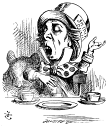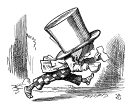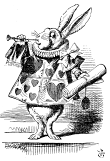Search us!
Search The Word Detective and our family of websites:
This is the easiest way to find a column on a particular word or phrase.
To search for a specific phrase, put it between quotation marks. (note: JavaScript must be turned on in your browser to view results.)
Ask a Question! Puzzled by Posh?
Confounded by Cattycorner?
Baffled by Balderdash?
Flummoxed by Flabbergast?
Perplexed by Pandemonium?
Nonplussed by... Nonplussed?
Annoyed by Alliteration?

Don't be shy!
Send in your question!
Columns from 1995 to 2006 are slowly being added to the above archives. For the moment, they can best be found by using the Search box at the top of this column.
 If you would like to be notified when each monthly update is posted here, sign up for our free email notification list.
If you would like to be notified when each monthly update is posted here, sign up for our free email notification list.
Trivia
All contents herein (except the illustrations, which are in the public domain) are Copyright © 1995-2020 Evan Morris & Kathy Wollard. Reproduction without written permission is prohibited, with the exception that teachers in public schools may duplicate and distribute the material here for classroom use.
Any typos found are yours to keep.
And remember, kids,
Semper Ubi Sub Ubi
|
Dear Word Detective: I have somehow gotten the impression that “pushing the envelope” means encroaching on forbidden territory in a conversational sense. I would like to know if this is so. If I am correct or not, from where did the expression come? – Rene Guggisberg.
Good question. I think I know what you mean, as when you say something like “Lovely engagement ring, Debbie. Is that the one Dave got on eBay?” Conversations can be tricky. Personally, I have a tendency to answer people’s rhetorical questions literally, and folks who make the mistake of asking “Why me?” in my presence often get five or six good suggestions.
I have actually answered a question about “pushing the envelope” before, but I see by the clock on the wall that it’s been almost exactly ten years, so we’ll take another run at it. To “push the envelope” does include straining the boundaries of polite conversation, but more broadly it means to approach, exceed, or even extend the limits of what is considered possible or permissible in any context. This can be a good thing, as when a race car driver sets a new world’s record time, or a bad thing, as when an office worker sets a new record for calling in sick. In both cases, the attempt itself carries a risk considered too great by most people.
“Pushing the envelope” comes from a field, however, where tremendous risk is the whole point. It’s drawn from the lingo of test pilots, whose job consists of pushing their aircraft right up to and often beyond the technical specifications and theoretical limits of their craft. While “pushing the envelope” (originally in the form “pushing the edge of the envelope”) has probably been in use among test pilots since World War II, it was propelled into general usage by Tom Wolfe’s 1979 book about test pilots and the early US space program, The Right Stuff. The “envelope” being pushed in “pushing the envelope” is a mathematical construct, what is called the “flight envelope” of a given aircraft: combinations of speed and altitude, range and speed, or speed and stress on the aircraft’s frame, that are considered the limits of the plane’s capabilities. Within the “envelope” formed by these parameters, you’re (at least theoretically) OK. Push those limits and you’re asking for trouble, which is what test pilots do for a living. In the process, they verify the safety of the aircraft within those limits and pinpoint possible points of failure if the “envelope” is pushed too far.
Given the popularity of Tom Wolfe’s book (and the movie made from it), it’s not surprising that by the early 1980s “push the envelope” was being used in non-aviation contexts with the diluted meaning of “experiment, innovate, take risks” (“Steven Bochco is offering a new series this fall on ABC, ‘NYPD Blue,’ that … will ‘push the edge of the envelope’ of profanity, nudity and artistic violence,” 1989).
Dear Word Detective: So okay, I lived a few years in Philly, I’ve moved on. But I always called what is otherwise a “big shot” a “big mahoff.” My grown daughter tried to research this when she got blank stares after using it around friends, and it seems to be a totally local expression. I tried to verify this tonight (rather than going back to work), and she seems to be right. Most of the citations are by Philadelphians, about Philadelphians or in Philadelphia publications. Whaddayathink, is this really just a Philadelphianism? — Diane Yaghoobian.
Could be. Maybe it refers to the guy who invented the cheesesteak, a.k.a. the Coronary Event on a Bun.
There must be something going on in Pennsylvania. The two largest cities, Philadelphia and Pittsburgh, are both famous in linguistics circles for their idiosyncratic slang, terms often heard nowhere else on the planet. Natives of Pittsburgh, for instance, apparently call baloney sandwich meat “jumbo.” Put that baloney on a long roll with lettuce, tomato, etc., and you have what much of the rest of the US calls a “submarine sandwich” (or just a “sub”), but is known in Philadelphia (and southern New Jersey, to be fair) as a “hoagie.” Philadelphians also apparently call the sidewalk “the pavement.” Can you say “lost colony of space aliens”? I knew you could.
Now that I’ve ensured myself lots of mail from hoagieland, on to “mahoff.” As you’ve discovered, this is evidently a seriously obscure term outside of Philadelphia. It’s not defined in any major dictionary, it’s not listed in the Historical Dictionary of American Slang (HDAS), and it’s not even in the Dictionary of American Regional English (DARE), the gold standard of glossaries of weird local terms. Fortunately, Grant Barrett, a lexicographer at Oxford University Press, project editor of HDAS and proprietor of the Double-Tongued Word Wrester Dictionary website (www.doubletongued.org) did a write-up on “mahoff” in January 2005. He found print citations dating back to 1951, all using “mahoff” or “big mahoff” in the sense of “big cheese” or “important person.” Grant later contributed to a discussion of “mahoff” at Dave Wilton’s wordorigins.org site in which various origins from Irish to Russian were discussed, but no conclusion was reached. So, for the moment at least, “mahoff” remains a mystery.
Dear Word Detective: I just read the following explanation of the origin of the martini (on a website about kayaking, if you can believe it): “…and the martini itself resulted from a gold miner wandering out of the wilderness and into a saloon in Martinez, California (1862). He wanted an empty whiskey bottle filled with something worth the weight of his small pouch of gold, and thought just plain whiskey wouldn’t cut it. So the bartender filled it with a concoction of lesser-known spirits hidden behind the bar, plopped an olive in it, and labeled the drink after the town.” My gut feeling is that the chance of this being true is approximately zero. What do you think?– Carl Delo.
Well, I think that your gut feeling is probably correct, at least as far as that story being literally true goes. First of all, prospectors wandering into saloons in dusty western towns are second only to sailors on 18th century frigates as heroes of bogus word-origin tales. In this case, the probability of a prospector trading even a small bag of gold for a single bottle of anything strikes me as unlikely. If I’d been crawling around in the desert for a few weeks, I’d definitely be interested in quantity (probably of “just plain whiskey”) over the quality of a bartender’s inventiveness. On the other hand (and it pains me to even partially validate that silly story), the town of Martinez, CA, may actually have been the source of “martini.”
This seems like a good time to note that I don’t drink at all, and have actually never had a martini. Weird, right? My idea of fun is black coffee and oatmeal cookies. Anyway, a “Martini,” which the Oxford English Dictionary insists on capitalizing, is a cocktail usually made from gin and vermouth, although vodka is sometimes substituted for the gin. Incidentally, according to Cecil Adams’ Straight Dope web page (www.straightdope.com), James Bond’s famous “shaken, not stirred” martini was actually a hybrid of the two types, mixing both vodka and gin with the vermouth. Apparently Bond also had a license to annoy bartenders.
There are two theories about the origin of “martini,” and the truth may actually be a blend of the two. Early print citations mentioning the drink, around 1884, call it a “Martinez cocktail,” and assert that it took its name from the California town, which is certainly not impossible. But within a few years (1887), the Brooklyn Daily Eagle was calling the concoction a “Martini cocktail.” The second theory ties “Martini” to Martini & Rossi, Italian makers of vermouth, which was definitely in business and exporting to the US at that time.
The connection of “Martini” the maker of vermouth to the “martini cocktail” containing vermouth seems a no-brainer, but the earlier citations for “Martinez cocktail” pose a problem. The Oxford dictionary suggests that the original name was “Martinez,” perhaps commemorating its invention there, but that the name gradually was “remodelled” after Martini & Rossi vermouth became well-known. This seems very plausible, especially since Martini & Rossi bottles would have been clearly visible in nearly any bar, while Martinez, CA, is an awfully long way from Brooklyn.
|
Makes a great gift! Click cover for more.  
400+ pages of science questions answered and explained for kids -- and adults!
FROM ALTOIDS TO ZIMA, by Evan Morris
 
|


 can be found
can be found 




Recent Comments